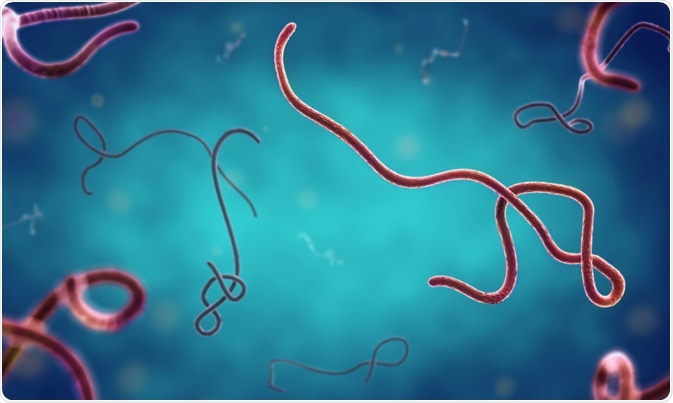The Filoviridae Family
First discovered in 1967, the filovirus refers to any virus that belongs to the Filoviridae family of viruses that sit within the Mononegavirales order. Three genera are included within the family: Cuevavirus, Ebolavirus, and Marburgvirus.
 Image Credit: [email protected] / Shutterstock.com
Image Credit: [email protected] / Shutterstock.com
The latter two primarily infect vertebrates with a focus on primates, whereas the more recently recognized Cuevavirus has not been seen to favor primate infection, with early research focused on investigating the virus in bats.
To date, six distinct species of Ebolavirus have been discovered, including the Ebola virus, Sudan virus, Taï Forest virus, Bundibugyo virus, Reston virus, and Bombali virus. Research has shown that four of these virus species (Ebola, Sudan, Taï Forest, and Bundibugyo) cause disease in humans. Reston virus causes disease in primates other than humans and also pigs. Bombali virus, like Cuevavirus, has been found to cause disease in bats but it has yet to be shown to cause disease in humans.
There is one known species of Marburgvirus, known as Marburg marburgvirus, and is represented by two viruses (Ravn virus and Marburg virus) which are known to cause serious disease in humans and other primates.
Finally, the newly discovered Cuevavirus encompasses just one virus, the Lloviu cuevavirus. At this point, it is unclear whether this virus causes disease in humans.
Filovirus History
Filoviruses have only been recognized for several decades following an outbreak of hemorrhagic fever amongst laboratory works in Germany and Yugoslavia who had been working with green monkey tissues. 31 workers became infected and 3 died from the virus which was named after the site of one of the outbreaks, Marburg, Germany. Since then, scientists have investigated the nature of filoviruses and have discovered more species in the family.
Filovirus Structure
Filovirus virions can change in structure, taking on different forms as a result of pleomorphism. Often, the structure of the filovirus includes long filaments that are often branched. Additionally, shorter filaments are also common and are found in “U” shapes, “6” shapes, or circles.
Both are encased by lipid membranes. The complete genome of a filovirus is roughly 18,900-19,000 bases in length, measuring around 14,000 nanometers in length, and 80 nanometers in diameter.
Each filovirus virion has one single-stranded molecule of negative-sense RNA. Transcriptional start and termination signals define and conserve genes within the virus, which are linearly arranged. To create new viral particles the filovirus virion attaches to the host cell and buds from its surface, although the full process of filovirus replication is still unknown and requires further research.
Transmission
To date, research has not uncovered the natural reservoir of the Ebolaviruses that cause Ebola hemorrhagic fever in humans. For this reason, the exact nature of how the virus is transmitted to humans remains unclear. However, research has revealed that the virus is able to spread between people via direct contact with the blood or bodily fluids of an individual who is infected.
The Marburg virus, which causes Marburg hemorrhagic fever, is transmitted to humans from animals who act as a host for the virus. The virus can also spread from person-to-person via direct contact with infected blood or bodily fluids.
The general route of transmission for the family of filoviruses is person-to-person via intimate contact. Data shows that transmission, however, is inefficient. Ebola virus outbreaks have been particularly characterized by nosocomial transmission, which has proved difficult to prevent. Studies suggest that filoviruses are endemic in central African nations, with all outbreaks of human filoviral hemorrhagic fever being traced back to an African origin.
Prevention
Currently, no vaccine has been developed to tackle the virus. This has made early diagnosis vital for preventing outbreaks of diseases caused by filoviruses. Experts also recommend that infected patients should be isolated to help prevent the further person-to-person spread of the virus. Additionally, protective clothing should be worn by medical staff while working with infected patients, and HEPA-filtered respirators should be used to further prevent person-to-person transmission.
Diagnosis
Given the importance of early diagnosis, effective and reliable diagnostic methods are key to controlling outbreaks of filoviruses. Currently, several tests have been developed that can detect antibodies of filoviruses within samples of blood and cerebral spinal fluid.
In addition to antibody tests, diagnosis of infection is also suggested by clusters of cases of prodromal fever and hemorrhagic diathesis. Confirmation of infected is then determined via measurements of the host-specific immunologic response, detection of viral antigen and genomic RNA, and virus isolation.
Those at Risk of Filoviridae
People who work closely with African fruit bats or bushmeat of non-human primates are at an increased risk of contracting filoviruses. Medical staff who work with infected patients are also at a greater risk of infection.
Filoviruses represent a significant threat to human health, and more research is required to fully understand how they are transmitted, in order to develop better preventative techniques.
Sources
Ebola virus disease. World Health Organization. Available at: https://www.who.int/news-room/fact-sheets/detail/ebola-virus-disease
Emperador, D., Mazzola, L., Wonderly Trainor, B., Chua, A. and Kelly-Cirino, C., 2019. Diagnostics for filovirus detection: impact of recent outbreaks on the diagnostic landscape. BMJ Global Health, 4(Suppl 2), p.e001112. https://gh.bmj.com/content/4/Suppl_2/e001112
Negredo, A., Palacios, G., Vázquez-Morón, S., González, F., Dopazo, H., Molero, F., Juste, J., Quetglas, J., Savji, N., de la Cruz Martínez, M., Herrera, J., Pizarro, M., Hutchison, S., Echevarría, J., Lipkin, W. and Tenorio, A., 2011. Discovery of an Ebolavirus-Like Filovirus in Europe. PLoS Pathogens, 7(10), p.e1002304. journals.plos.org/.../journal.ppat.1002304#ppat.1002304-Kuhn1
Viral Hemorrhagic Fevers (VHFs). Centers for Disease Control and Prevention. Available at: https://www.cdc.gov/vhf/virus-families/filoviridae.html